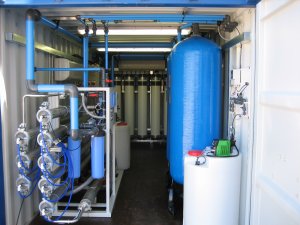Many families in the United States rely on wells as a natural source of drinking water. When it rains, ground water settles into the space just above the dense rock barrier under soil. It is this aquifer that feeds wells. Currently, over 15 million homes in the United States rely on well water. Since the ground water contains contaminants that cause illness, it is crucial to understand the risks of using a well and learn how to avoid them.
Drawbacks of Well Water
The Environmental Protection Agency tests and treats public water sources, but wells do not fall under their regulation. Water that comes directly from a well will contain some contaminants if not filtered or treated in some way. The CDC lists the top five dangers of untreated well water as:
- Hepatitis A

- Giardia intestinalis
- Shigella spp.
- E. coli
- Salmonella
Whatever goes into the ground can eventually end up in well water. This includes heavy metals like mercury and lead as well as chemicals and pesticides. Using a well water source is especially dangerous for those immune-compromised due to chemotherapy or chronic illness.
Testing
Well water testing is something homeowners should do at least once a year, preferably in the springtime. Local health departments can be contacted for information on testing. Many times, these agencies will test water at no charge. Tests look for nitrates, volatile organic compounds, pH level and contaminants that cause disease and illness. If the local health department does not offer testing, they will be able to offer names of state-certified laboratories in the area that will check a water sample. Testing is the only way to know that the well water is safe to drink. It is vital to test every year, because as snow melts, the earth absorbs new compounds that may end up in drinking water. Just as air quality changes so can the components in ground water.
Water Filtration Systems
One of the most effective ways to prevent water contamination is through a filtration system. Ideally, families should have a main filter installed in the plumbing near the well pump. This is a frontline way to clean water coming into the house. A second filtration system can be set up for drinking water. Having a refrigerator with a spigot and a filter such as a Samsung refrigerator water filter comes in handy. The filtration system is built into the line feeding the appliance to clean water for drinking and ice.
Other options for drinking water filtration include a system that attaches to a household water faucet. When getting water to drink, these systems simply require a switch be flipped to begin filtering the water. Filter pitchers that cleanse the water are also a viable alternative to non-filtered well water.
Water Softeners
Water softeners will remove some heavy metals from ground water and often have a filtration system to remove contaminants. A water softener will also protect the plumbing from a buildup of lime scale. Most water softening units work on an ion-exchange platform. They pull out the calcium and magnesium in the water and replace it with sodium or potassium.
Distillation Systems
A distillation system uses heat to purify water. When water boils, it produces a vapor. One manner of distillation involves heating the water to create vapor and then trapping the steam. As the vapor cools, it creates condensation that becomes clean water. This is the basis for distilled water purchased in stores.
A simple, inexpensive way to use distillation to clean water is to boil it. Boiling heats the water to the point that all microbes die off. When there are problems with the public water supply after a storm, officials often suggest boiling drinking water to purify it. Distilling well water may not be an effective way to remove heavy metals, but it will kill microorganisms.
Disinfection
Water can also be chemically disinfected. This is what happens to pool water – chlorine is added to kill any bacteria that are in the water. Some home systems add a small amount of a chemical substance such as chlorine, chlorine dioxide or ozone to treat well water. Water collects in a tank to be treated before it comes through the pipes. Chemical treatment kits provide the tools and instructions for home water disinfection.
There are methods to disinfect water without using chemicals, as well. Physical disinfectants include ultraviolet light and electronic radiation. As with distillation, disinfecting is meant to kill organisms not filter out heavy metals.
Homes can be set up with more than one method of treating well water to make it safe to drink. A combination of treatments will ensure removal of both metals and bacteria. The risks of using untreated well water far outweigh the small cost it takes to protect families from the dangers. By drinking pure ground water, US citizens risk contamination from possible life-threatening microbes and heavy metals. Treatment and testing is the only way to stay safe when relying on well water.

























Leave a Reply